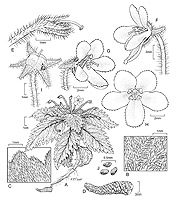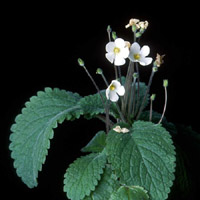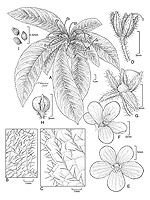Amalophyllon
Full name and orig. publication: Amalophyllon Brandegee, Univ. Calif. Publ. Bot. 6(4): 63 (1914).
Etymology: From the Greek άμαλός, amalos = soft, tender and φυλλον, phyllon = leaf.
Synonyms: Phinaea p.p.
Infrafamilial position: Gesnerioid Gesneriaceae (Gesnerioideae) - Gloxinieae
Description: Terrestrial or saxicolous, subacaulescent to caulescent herbs with scaly rhizomes. Indumentum minutely puberulous, pilose, strigose or strigillose, sometimes glandular-pubescent. Stem erect or decumbent, usually unbranched. Leavesopposite, subequal to unequal, frequently congested at the top of the stem, subsessile to short- (rarely long-)petiolate; lamina elliptic, oblong, ovate, or lanceolate, apex acute to acuminate, leaf bases cuneate to decurrent, rarely rounded cordate, frequently unequal or oblique, with (4–)6–10(–17) pairs of side veins; margins crenate, dentate, serrate, biserrate, or lacerate; membranous (papery and fragile when dry), green, purplish, or brownish (sometimes with dark markings). Inflorescences axillary, epedunculate or rarely with a short peduncle, ebracteolate or with minute bracteoles, with (1–)4 flowers congested in the axil. Pedicels long, slender, frequently curving below leaves in fruit. Calyx 5-lobed, lobes elliptic to lanceolate. Corolla 5-lobed, erect in the calyx, rotate to subrotate with a very short tube, white or rarely tinged pink, lobes entire, often with a fringe of glandular trichomes. Stamens 4, inserted at the base of the corolla, staminode 1, filaments curved, anthers coherent or free, thecae oblongovoid to subglobose, divergent, dehiscing by a short slit or pore. Nectary absent. Ovary semi-inferior to almost superior, ovoid to subglobose; style slender, curved, longer than the stamen filaments; stigma capitate to stomatomorphic, rarely bilobed. Fruit a subglobose to ovoid dry bivalved loculicidal membranous capsule, lacking stiff hairs on the internal margins, opening slightly at dehiscence. Seeds numerous, minute, ca. 0.3–0.4 mm, fusiform to subglobose, spirally striate.
Chromosome number: 2n = 26, 52
Species number: 13 (plus 1-2 undescribed)
Species names (incl. publication and synonyms): See Boggan, Skog & Roalson (2008) and Skog, L.E. & J.K. Boggan. 2005: World checklist of Gesneriaceae: http://persoon.si.edu/Gesneriaceae/Checklist.
Type species: Amalophyllon rupestre Brandegee
Distribution: Central America (southern Mexico to Panama) and South America (Andes from the eastern range of Venezuela to central Peru)
Ecology: Growing in colonies on shaded wet rocks or cliffs in forests, frequently near streams, rivers or waterfalls, or at the mouths of caves.
Notes: The genus was originally described in Scrophulariaceae and only recently recognised to belong to Gesneriaceae. The majority of the species previously included in Phinaea belong to this genus. See Boggan, Skog & Roalson (2008). Amalophyllon and Phinaea are very similar in habit and floral characters. The most important morphological characters separating the two genera are characteristics of the fuits. Phinaea fruits are held erect above the foliage and are fleshy at dehiscence, with the valves splitting broadly (to 180 degrees) and the sticky seeds adhering to them. In contrast, the fruits of Amalophyllon are held on a slender curving pedicel, often below the leaves; the membranous capsules open only slightly, with the seeds falling freely from it (salt-shaker style). For the differences to Niphaea, a third genus very similar to Amalophyllum and Phinaea, see under that genus.
Selected references: Boggan, Skog & Roalson, Selbyana 29(2): 157–176 (2008).
Bibliography: See Skog, L.E. & J.K. Boggan.
2005. Bibliography of the Gesneriaceae. 2nd edition: http://persoon.si.edu/Gesneriaceae/Bibliography.
Illustrations:
 |
Amalophyllon clarkii J.K.Boggan & L.E.Skog
Boggan, Skog & Roalson (2008), Fig. 1.
|
 |
Amalophyllon divaricatum (Poepp.) J.K.Boggan & L.E.Skog
Cult. Smithsonian Institution, Ecuador, Wiehler/GRF collection (as Phinaea ecuadorana Wiehler), phot. J.K. Boggan
|
 |
Amalophyllon macrophylloides J.K.Boggan & L.E.Skog
Boggan, Skog & Roalson (2008), Fig. 2.
|
last modified: 2010-09-22


